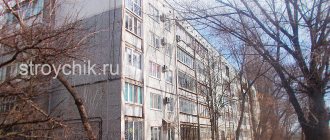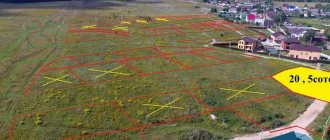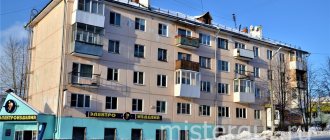What is the height of a 5-story building in meters? Many people say that the height of a five-story building is 15 meters. This is determined by calculating the number of floors per floor height, which is taken to be 3 meters. In fact, this is not entirely true and the height of the house can vary from 14 to 20 meters or more. How it differs and what it is needed for, let's find out.
SNiP gives a classification of buildings by number of storeys. According to them, five-story buildings are classified as mid-rise residential buildings (MRB). Then there are houses with higher floors, that is, 6-9-storey buildings with a height of 30 meters, multi-storey buildings - 10-16 and multi-storey buildings over 17.
You can correctly calculate the height of each house if you know several parameters. This is the height:
The main parameter, of course, is the floor height. Based on it, you can determine the height of at least 2 or 14 floors, so let’s look at this value.
Floor height in the apartment
Floor height is simply the distance from the floor level to the floor above. As mentioned above, when calculating the height of a building, it is customary to take a value of 3 meters. In fact, this meaning was only in five of Stalin's stories. Ceilings in Khrushchev buildings usually ranged from 2.45 to 2.64 m.
Ceiling height in a 5-story panel house.
Previously, the norm was calculated based on the volume of air in the room, so in the Stalin years the ceilings were the highest and amounted to 3.2 meters. However, apartments from that time are still valued today. And it was during his reign that the construction of five-story buildings began, which began to be replaced by four-story ones.
Under Khrushchev, construction began on a series of standard 5-story buildings, but the economy was already in first place. The inconvenience and the number of square meters ordered were assessed. By saving the distance between floors, many more apartments can be built. The unification of apartments made it possible to quickly build entire neighborhoods.
With Brezhnev coming to power, the construction of standard panel houses continued, but more comfortable ones. Although the distance to the ceilings in panel houses was 250 cm. However, there were more and more projects with 270 cm. In the 5-story brick house, the ceilings were much higher - 2.8 cm.
Currently, there is no standardized ceiling height, but SNiP guidelines state that a ceiling height of 2.5 meters or more is considered a residential height. Based on these values, the average ceiling height in an apartment is 2.8 m.
To this value we should add the thickness of the interfloor ceiling of 16-22 cm. In total, we get an average floor size of about 3 meters.
Modern construction
In the last years of the existence of the USSR, improved projects were introduced, for example, the Czech one, which had a large kitchen and 1-2 loggias. But state standardization and a unified catalog of construction parts somewhat limited the difference in size.
Eternity
The projects provided for ceiling heights that were higher than those of the squat and unsightly Khrushchev building, but the significant difference in the vertical size of the five-story building was still not very noticeable. If you measure how many meters to the fifth floor window of an improved design of a brick multi-story building, then both this parameter and those that were in 5-story buildings would hardly exceed 22.5 meters.
A modern project is not limited by any state standards, except for the requirements for the quality and composition of building materials. Housing and public construction must be carried out from materials that comply with GOSTs approved in the Russian Federation. This is due to concern for the safety of people, not only those who move into the building, but also passers-by and residents of neighboring houses.
Typical floor plan
Buildings made of monolithic concrete and individual design may involve a building height of five floors ranging from 22 to 28 meters. Here, when making calculations, a strong high foundation, a gable roof, a ceiling height of 4 meters and other architectural components can be taken into account.
Ground floor and roof
Almost all apartment buildings start with a basement. Ground floor with connected internal communications: water, gas, sewerage. Part of the basement rises above the ground and forms part of the total height of the five-story building. As you can see in the photo below, the increase in height is at least 1.5 meters and it is significant. However, most often it is about 100 cm.
Basement of a 5-storey building
This floor is part of the foundation, and the entire house rests on it. A five-story house with one entrance door weighs approximately 8-9 thousand. tone. However, houses are usually built with 2-4 entrances. Together with the residential floors it will be: 5 * 3 + 1.5 = 16.5 m.
The roof also contributes to the height and, depending on the design, can be hipped or flat. For a gable roof, the allowance can be up to 5 meters. In this case, the total size will be already 21.5 meters.
Gable roof of a 5-storey building
If the roof does not have slopes, only the parapet size will be added to these values. This is a closing structure with a height of up to 100 cm. In total, we get 17.5 m. This is also more than what was originally expected at 15 m.
Window sill on the roof
However, if we take typical panel houses with 5 floors with a ceiling of 2.5 m (floor 2.7 m), a baseboard of 1 m and a window sill of 0.5, we get: 1 + 2.7 * 5 + 0.5 = 15. More often However, this is different and depends a lot on the standard design on which the house was built.
Vertical dimension definition
- Foundation + roof. The depth of the foundation is different everywhere. For example, -2.20 m + 5 m = 7.5 m. The height of the floor with ceilings is about 3 m. Thus, the height of a five-story building will be 22.5 m.
- If the house does not have a basement, and the vertical from the ground is 1.5 m, then we take into account the height of each floor along with the ceiling - 15 m. Add the height of the roof (according to the standard 5 m) We get -21.5 m.
- It would be easier to determine the height of a house if there was a standard vertical floor dimension. But there is no standard. Because the design of houses has always been different. Some had a basement and a pitched roof. Others have a basement and attic. Houses with a basement and mezzanine were built. Houses with a flat roof but with a 2.5 m basement were also built.
- So, on average, a 5-story building is really about 15 meters long, it all depends on the thickness of the ceiling and the height of the floor.
- The first brick houses could reach a height of 14 m. The ceiling height was small - 2.40 m. By the way, in “Stalinist” houses the amount of air per person was taken into account. When planning the “Khrushchev buildings” at the initial stages, such nonsense was not of interest.
- Soviet-era houses are a thing of the past. Along with them are standard projects with GOST standards, standard blocks and parts. Therefore, it is simply impossible to determine at what height the apartment is located if you do not know the design of the house. Thus, a five-story building, taking into account the roof, can be 22-28 m vertically.
The height of a five-story building. A variant of a standard house design with 2 entrances.
Typical buildings of the USSR
Typical panel and brick 5-story houses began to be actively built in Khrushchev since 1957. The country needed cheap apartments as soon as possible. Therefore, projects were developed, some for the southern regions and some for the northern. This brick had a slightly better layout and room sizes.
The same massive design erected in different regions may be slightly different. Different climatic conditions and the land on which the construction was carried out brought their own adjustments to the size of the five-story buildings. Obviously, each project was different in terms of building height.
The length of a 5-story building with 4 entrances for a typical 5-story building 1-528-3K is 72.4 m. This depended on the layout of the building and to a small extent on the thickness of the panels. Thickness
The thickness range of wall panels is from 300 mm to 400 mm.
The length of the five-story building with 4 entrances is 72.4 m.
"Breifer" was built by the end of 1980. Successful projects are used as a basis even now. They were not very different from the Khrushchev, but the entrance was larger, the stairs were wider, and a garbage chute was installed.
Now that you know how tall a five-story building is, you can approximate the size of each building. In our calculations, we got values from 15 meters to 21.5. And if you want accurate data, you'll need to look for a full-size project.
Common types of Soviet-era buildings
In the terminology of real estate agents and those involved in rental housing, terms constantly appear that are not always familiar to the average person. These are conditionally generalized names of buildings erected in a certain period, when construction was carried out at an accelerated pace. Initially, the construction of houses with higher number of floors began with the 4th and 5th floors, but over time, preference was given to the latter. They suggested that more individual apartments could be given to people to relocate to.
Typical courtyard of a 5-storey building
An undeniable advantage compared to even taller buildings is the ability not to equip an elevator, which means saving additional money. According to building standards, it was on the fifth floor that the opportunity to do without an elevator, its shaft, lifting mechanism and additional costs for repairs and maintenance ended.
History of 5-story buildings
Five-story houses began to be built in Moscow and St. Petersburg even before the war, but after its end in 1948, the first attempts to build experimental houses began using frames and panels as standard parts for assembly.
Brezhnevka
Based on the appearance and degree of wear after the operation, it is quite easy to distinguish three periods of Soviet construction, which usually bore the names of the then leaders of the country.
Over time, they have taken root in official documents, and now, when it comes to projects, three general terms are used:
- “Stalin buildings” are houses that have still retained a presentable and well-maintained appearance, since their useful service life is determined in the design to be 125 years or more. They can be easily distinguished by the presence of architectural decorations, stucco moldings, plinths, columns, Soviet paraphernalia, pompous style and the presence of high floors of public spaces in street buildings. The ceilings in the apartments of such houses were more than 3 meters, since the planning took into account a certain volume of air for each resident. “Stalin buildings” were always more than 20 meters in height due to the lamps between the floors and the strong roof that reliably protected the building.
- In a five-story panel house, the construction of which began during the Khrushchev era, the ceiling height was sometimes 2.48 m (all parameters depend on the standard project number). In order to save money, they first stopped building an iron frame, leaving only reinforced concrete panels; sometimes they did not build a full-fledged attic; in other cases there was no basement. Subsequently, the ceilings became a little higher, and then reached their maximum height when designing the last series (2.64 m), but the roofs were no longer gable, but flat, there were no more columns and plinths. However, for road buildings, a project with a raised ground floor was still used, in which premises for shops, organizations or public needs were built. Hence the approximate height of the Khrushchev building, which ranges from 14 to 15 meters.
- The construction of the Brezhnevka was carried out according to new, revised design documentation. Although the Unified Catalog of Building Parts was still used, such houses had wide staircases, ceiling heights of up to 2.7 m, almost everywhere there was a full attic and a deep basement. You can also visually determine that the Khrushchev panel is noticeably different from the Brezhnev one. In addition to the difference in height (even 20 cm on five floors is one meter without taking into account the attic and attics), there is also another aspect. They have completely exhausted the period for which the Khrushchev buildings were designed, and the more substantial building still looks relatively normal.
The construction project of
a 5-story brick residential building of the Stalin and Khrushchev eras is also very different in visual perception. The Stalinist house had a foundation and a gable roof, which occupied about 6.5 m, and with the addition of ceiling heights, this figure starts at 21.5 m. Although everything depends on the floors between floors, they were different. The growth of Stalin's People's Commissariat could have reached a higher point. Brick Khrushchev, where, for the sake of economy, there were no kinks and the ceiling height was less than 2.5 m, the vertical size could be 14 meters.
The height of a five-story building in meters: what determines the height of a Khrushchev building?
The design for the construction of residential buildings, popularly called Khrushchev houses, was created in 1957. Construction was aimed at providing for every family and reducing mass residence in council flats.
What were the first apartments like?
Chruszczowsa Vision of Hile Prose: a man should live in a small, but his own apartment. On this basis, the living area was reduced to 6-9 m2 in the bedroom and 6 m2 in the kitchen. The height of the ceilings did not exceed 2.5 m. At the same time, the height of a five-story building in meters is about 15 meters.
Construction features and nuances
The houses were originally built of brick, and the height of a five-story building in meters was about 14 m. A few years after construction began, the architects turned to a group to build five-story houses, which saved time and labor costs. Innovations were also introduced into housing - prefabricated houses had separate bathrooms.
- Grushchev's specifics were as follows:
- The height of a five-story building in meters depends on a number of structures;
- No attic, trash, elevator;
The load-bearing structures in such a house are external.
Building a house from panels is reminiscent of playing with a construction set: large panels and blocks are placed one on top and assembled. This construction method maximizes efficiency on the construction site. Therefore, a smaller building area is required, and labor-intensive and time-consuming processes are completely eliminated. These are the main advantages of the panel design.
Serial construction of panels
And only a few tens of years later, people began to realize that hrushers were far from an ideal apartment: poor insulation system, low noise absorption, not very useful space.
Already in the early 1960s, panel houses began to be introduced into the series, creating an entire estate with its own internal infrastructure. About 23 series of brick and storage houses with various mechanisms were created. At the same time, the height of five-story buildings differed in meters. It depended on the specifics of the structure.
Basement with an approximate height of half a meter to ground level, 5 floors with a height of 2.55 meters plus half a meter for the attic, the total height of a five-story Russian house was approximately 14 meters when it was a panel house and 15 meters for a house with a full roof and attach.
How to understand projects
"Stalin", Stalin's houses
All names come from the name of Stalin, during whose reign these houses were built. The main building material in the construction of Stalinist houses was brick. Brick houses were distinguished by higher number of storeys, elegant facades, spacious apartments and better sound insulation.
These are large and beautiful houses with Soviet attributes. The facade of the house was usually decorated with stucco decorations. The outside of Stalin's houses was covered with plaster; large "nomenklatura" houses could be faced with stone or ceramic tiles. These houses have a mezzanine floor. The dimensions to the ceiling are at least 3 meters. Hence the calculation of the height of the house. Therefore, the height of a five-story building is at least 20 m.
"Stalinka" is the common name for apartment buildings built in the USSR from the late 1930s to the late 1950s
After Stalin, Khrushchev began to fight against “excesses,” and before Khrushchev’s mass construction, “stripped” Stalinist houses were built without stucco decorations and often without plaster.
How many meters high is a 5-story building: brick and panel Khrushchev buildings
The history of the construction of five-story houses has been around for decades; for example, in the Soviet Union it began with the construction of experimental buildings as part of a project to build a frame-panel house in 1948.
This does not mean that there were no five-story houses in the country before, but this was the first attempt to build from standard parts according to a certain rule.
The project was implemented by Gosstroproekt, Mosgorproekt and the USSR Academy of Architecture. The consumption of iron for the frame, even after the introduction of a more economical rule, was high, so two years later in Moscow, Leningrad, Magnitogorsk and other cities they began to build panel houses without a frame.
Khrushchev buildings are the most common type of housing construction on the 4th and 5th floors. This was due to the need to provide housing for large numbers of people, due to their relocation to large-scale construction projects, or to the urgent need to relocate municipal housing to large cities, which was the result of rapid industrialization.
Typical series of Khrushchev buildings: the main pros and cons of houses
Let's look at the main features of the apartments and determine the features of each series of Khrushchev buildings built over 27 years. It is worth noting that initially Khrushchev buildings were intended for temporary housing, and the service life of the building ranged from 25 to 50 years. But, as you know, nowadays people live in these houses. The disadvantages of Khrushchev include poor sound insulation and thermal insulation (cool in winter and too hot in summer), not always good layout of the apartment and entrance: narrow corridors, small kitchen, lack of a pile of garbage and very often an elevator. The main advantages of such houses include their low cost.
The main advantages of such houses include the low cost of housing and developed infrastructure around the house. As a rule, not far from Khrushchev there are kindergartens, schools, shops and excellent transport links. If you don’t have enough money to buy an apartment, then Khrushchev apartments are not the worst option. In addition, such buildings in Moscow and other Russian cities are subject to demolition, in which case the owners receive new housing or reconstruction and redevelopment.
The beginning of the era of five-story buildings
The need to restore the destroyed national economy, make capital investments in the modernization of industry and at the same time build at state expense led to the fact that brick houses without comfort, one- or two-story houses and residential buildings, called “Stalins”. ”, were practically replaced by the construction of standard reinforced concrete slabs.
The 5-story format replaced the 4-story format due to the possibility of building more apartments without the need to build an elevator, which also
at that time they were saving money. The height of Stalin's houses exceeded standard Khrushchev houses due to the height of the ceilings, which was at least 3 meters, as can be seen in the photo.
Standard construction
The construction of houses of this period is also characterized by the construction of upper floors for shops, workshops, post offices and other important social facilities. Even such workhouses were designed to last 125 years, and major renovations continued to extend their life.
The multi-pitched roof, which also has a long service life, further increased the height of the building. By the standards of that time, the height of a five-story house with a three-meter ceiling and a hip roof could be 20 meters, unless the building had a higher floor than the others.
It is no coincidence that the style of construction of five-story panel houses is called functionalism. All individual features such as pediments, chisels and other architectural elements were removed from the standard design. However, calling such a design impersonal and unambiguously calculating the height of five-story panel houses is very problematic.
The ceiling height in various projects ranged from 2.48 m, sometimes 2.6 or 2.64 m, later construction began with a height of 2.7 m.
Vertical dimension definition
When calculating for 5 floors, a difference of 20 cm is equal to one meter of additional height.
Roofs were originally covered with tiles or slate, but in the era of architectural controls on excess, they became flat because they were cheaper. Bituminous roofs had a smaller attic area, different ground floor height, basement depth, etc.
When determining the height of a panel house, the project, its quantity, parameters provided by developers, and much more, see an example in the photo.
Standard and individual projects
The exact height of a 16-story building is determined only by the existing project. In the era of state planning, when the need for low-cost housing was great, all standard projects were considered.
In addition, coordination was carried out in ministries and special commissions, and the parameters were chosen not so much based on the convenience of the consumer, but rather on the possibility of reducing costs and saving:
- At a time when the scale of construction was colossal, even small cost savings produced amazing results, allowing the construction of thousands of new square meters of living space.
- The cheapest building was recognized as a five-story panel house. This saved money on fire escapes, installation of elevators, stairs, attics and basements. Soon after, the option of building nine-story buildings appeared, which reduced the development of agricultural areas in width. At the same time, we saved money on fire escapes.
- It was the construction of panel houses that made it possible to achieve maximum benefits: the height of the nine-story building made it possible to extinguish fires with ordinary fire department equipment. At the same time, for the production of building parts according to standard projects, only a slight reconstruction of construction factories was required, and for a brick factory in small towns no re-equipment was required.
Design nuances
There is no need to talk about a comparative analysis of projects of the Khrushchev and Stalin eras with later development, which began in the late 1970s. Because before the start of the Brezhnev period of large-scale construction, preference was given to buildings with exactly 5 floors.
We gave away quite a lot of apartments, allowing us to save a lot of money.
Even a six-story building, according to state standards, required an elevator, but a five-story building could do without it.
The construction of high-rise buildings, according to the designers' calculations, was more expensive. And not only to equip more powerful elevators at significant heights and more passengers. Significant costs were attributed to the cost of the roof and underground part, as well as the entrance and exit of more users.
The sixteen-story building appears to be saving money. Instead of 3 roofs, the house has only one, as well as a well, a basement and entrances. But a decrease in the cost of 1 16-story building (instead of 3 standard 5 houses) by 6-7% led to an increase in prices for other parameters.
It was necessary to strengthen the supporting structures, stairs and elevator block. In addition, temporary elevators had to be built to accommodate the construction of the upper floors. It was possible to build a house with more floors (12, 16 or more) only according to the standards of the state project.
However, it is difficult to give an unambiguous and accurate answer to the question of how many meters tall a 16-story building is, since it depends on many factors. Projects for such buildings were developed in Moscow, Leningrad, Kyiv and other regions of the USSR.
Khrushchevka. Khrushchev buildings
The history of mass panel housing construction began in 1955, when the Decree of the Central Committee of the CPSU and the Council of Ministers of the USSR “On the elimination of excesses in design and construction” was issued, which ordered the development of standard projects so that by 1980, when communism came, every Soviet family would meet it in separate apartment.
The basis for the design of Khrushchev houses was laid by the building regulations of 1957, which provided for a living space height from floor to ceiling of 2.5 m, miniature (from 4.5 sq. m.) kitchens, and also allowed the construction of adjacent rooms and combined bathrooms. The required elements of the apartment were a pantry (or built-in wardrobe), bedrooms (6 sq. m for one person, 8 sq. m for two), a common room (at least 14 sq. m).
There was a joke about the five-story houses of the first industrial generation that Khrushchev “combined the bathroom with the toilet, but was not yet able to combine the floor with the ceiling.” Meanwhile, it was thanks to mass housing construction, put on an industrial footing in the late 1950s, that many Leningrad families were able to leave communal apartments. Even though it was proposed to accommodate two or even three generations in three rooms of a five-story building, each apartment had hot water and its own bathroom.
The disadvantages of five-story buildings, traditionally considered the cheapest class of St. Petersburg housing, are already well known to potential buyers. They do not have an elevator or garbage chute. But they also have undeniable advantages. Firstly, Khrushchev buildings are repairable: their renovation with the replacement of utility networks and insulation of facades can solve all problems, except for the lack of square meters. Secondly, the main microdistricts where St. Petersburg Khrushchev buildings are located are no longer city outskirts. These circumstances predetermined the good liquidity of apartments in Khrushchev-era buildings in today's real estate market.
In different districts of St. Petersburg, different types of Khrushchev buildings dominate, which is historically due to the proximity of the development area to one or another house-building plant.
The coldest and the warmest
Khrushchev buildings are considered “cold” housing, but not all. The “brick” series (1-528KP and its modifications), as well as houses with external walls made of brick blocks (1-527), are, in principle, not inferior in thermophysical properties to “Stalinist” houses. Series 1-507 with an outer wall thickness of 40 cm is also not the worst option in this regard. The record holders for heat loss at home are the GI, OD and 1-335 series. The first - because of the constantly blown joints, the second and third - because of the design of the external wall panels that has not stood the test of time. The most problematic in this regard are the corner and three-sided apartments of the end sections.
Some owners of such apartments try to insulate them from the inside, creating a “layer cake” of mineral wool boards and plasterboard on a wooden frame. Unfortunately, this is ineffective. Insulation of external walls, especially of apartments located in the end sections, is a serious problem. The only reasonable solution to the problem is modern double-glazed windows and claims to representatives of operating organizations whose tasks include repairing facades and updating interpanel joints.
Features of Khrushchev renovation
In Khrushchev houses, unlike houses of later series, linoleum was not yet laid directly on the concrete base. As a rule, they have parquet or plank floors laid on joists made of boards or timber. This design creates quite acceptable interfloor sound insulation, but since construction, as a rule, was carried out in emergency mode, the space between the floor joists was usually filled with sand. Hence the ineradicable dust and constantly “walking” floors.
When overhauling such an apartment and replacing the floors, you have to remove a lot of garbage with “artifacts” from the times of shock construction: empty bottles and cans.
Redevelopment
Redevelopment for Khrushchev buildings is the most common thing. Perhaps only one-room apartments in them cannot be improved. The main thing that always suggested itself was to turn adjacent rooms in two- or three-room apartments into isolated ones, separating part of the common room with a corridor and depriving the back room of the storage room.
Therefore, when purchasing such an apartment, you should definitely check the improvements made with the data in the property’s passport. Insulated kitchens in GI series houses are also, as a rule, a consequence of redevelopment. Another piece of “creativity” is bathrooms with sitz bathtubs, which are being replaced with more modern shower stalls, but the improvement is not a remodel.
Five-story residential building with 50 apartments
Alexander 29
September 26, 2021
- 0
1 925
Working draft. Contains drawings: basement plan, 1-5 floors; explication of premises; roof plan; roofing units; cuts 1-1, 2-2; blind area unit; frame plan; floor plan; specification of elements for filling window openings; plan of the pile field; frame plan; reaming layout plan; reaming Rcm-1, Rcm-2, Rcm-3,
Project drawings / Architectural drawings. Multi-storey houses and buildings
Features and advantages of a brick five-story building
Features and advantages of a brick five-story building
- It does not heat up in the summer, as a result of which the apartment maintains a fairly comfortable temperature, even in the heat. In winter, in the house.
- The standard layout of a 5-story brick house implies good thermal insulation and sound insulation. An exception may be houses that are quite old, where the interior partitions are very thin.
- Often on different floors you can find apartments with different layouts from each other. Often in Khrushchev-era apartment buildings even hanging balconies were built, starting only from the second floor or not in all apartments.
- Often, five-story apartments with improved layouts are equipped with both a balcony and a loggia, which is very convenient for the owners.
- Load-bearing walls with a thickness of at least 64 cm and a reinforced foundation give a feeling of reliability. The house does not shrink and the likelihood of distortions is minimal, even on moving soils and in proximity to groundwater.
- Ventilation holes are made inside the walls. Therefore, there are no boxes spoiling the interior. In many old five-story buildings, ventilation is provided even under the flooring, this prevents dampness and mold during the cold season.
- Apartments in brick houses are very convenient for almost any redevelopment.
Note! For example, redevelopment of a 2-room Khrushchev-era building in a brick house will cost almost half as much and faster than in a concrete one. There is no need to demolish load-bearing walls with a hammer drill; excess can be carefully removed with a chisel and hammer.
- The environmental friendliness of housing is also important. As you know, people feel much better in houses made of natural materials. Plants and animals grow and develop better, this has been confirmed by many years of research.
- In a brick building it is possible to arrange a two-level apartment. This is very difficult to do in concrete analogues.
- In regions with increased seismic activity, homeowners can live in peace. A house with a reliable foundation and thick walls will stand firmly, without even cracking (see also article).
what is the height of a 9 storey building?
How many meters high is a 20-story building: the exact dimensions of a twenty-story building
titli 7 (89200)755229 12 years About 30 m. What a source! Logics. Add 2.5 m to each floor (this is an approximate standard) and + floors between floors and a roof.
Answers
- Forget-me-Not 7 (61833)12108338 12 years 25 meters. you will have time to say: Aaaaaaaaaaaaaaaaaaaaaaaaaaaaaaaaaa..
- BATMAN_ 7 (54200)667300 12 years
- sayleta (32) 6 (9969)353126 12 years
- RIFF_RAFF 4 (2025)29 12 years, the height is 9 floors - and that’s high!
- lolipopina (56) 6 (10689)31440 12 years
- Jaki4 (32) 3 (595)410 12 years old or you drank too much to ask this or swallowed coal
- Allower (31) 6 (19180)344109 12 years On average from 25 to 30 meters, because each country has different standards. Z.Y 2.5 + 9 = 11.5, not 22.5 f)
- neon- 4 (1511)1919 12 years 3 meters etazh te 3*9 = 27
- Leninec (2019) 6 (5856)1826 12 years ne zabudjte 4erdak i fundament pos4itatj
- FoxDude (29) 4 (1859)37 12 years old enough to kill yourself
- MarcJac 7 (24144)42460 12 years
- Ronuin 7 (33180)21329 12 years
- What is the height of an ordinary 16-storey building? Well, the basement usually sticks out by 1-15, the ceiling is a maximum of 30 cm, the ceiling height is 2.5, the attics vary from two to three meters. Well, count 2.5x16+0.3x19 (the overlap of the attic and roof can also be calculated) +1.5+2... In short, about 50 meters.
- The height of a 9-story building is 25 meters? 9 floors of 2.5 meters each = 22.5 + attic 3 meters + first floor slightly above ground, I think around 27-28
- where can I see an example of how to build an Internet network in a 5-story building, illustrations and diagrams?
- Which death is worse - drowning or falling/jumping from a high-rise building? If the situation is hopeless, there is nothing you can do... although if they choke, you can still pump them out if they have time... If you fall and survive, then you have a better chance of remaining a vegetable... then it’s better to drown. It’s worse than falling.
- what kind of abandoned 4-5 storey building is located on the left side of t/c Domina??? cVEF = TDV CITY.TDV CITY is no longer there..so draw for your health
- 20 How to solve a problem with grapes growing on the facade of a 5-story building? (Legal way) It’s better to just cut it off in the fall, dig it up and throw it away or give it to the grandmothers... yes, it’s clear that the grandmothers will find out... - you seem to be a lawyer, but you don’t know that this is illegal and is punishable for damaging state natural plantings, if this house is not private property (not cooperative). Contact the building management with a statement, for example, that mice are breeding in the vineyard and you will need to trim it in such a way that it does not blow your mind (does not interfere and does not reach your apartment facade, but again - without spoiling it - this is legal and humane. There is a vile, illegal option - this is to take it and spoil it from the very bottom, so that it does not grow up next spring and dries up over the winter (that is, kill it with poison, as suggested ).
- Guys, who knows where in Riga there are 9 (or more) storey buildings with an open roof? Please indicate the area, address and entrance number. Thank you in advance. This is not an option!) In general, if you want to visit the roof, then I advise you to choose remote areas of the country... it will take a little longer to get there. Ogre for example)
- What is the minimum height of a building that can be considered a skyscraper? I would say 30 floors, but that’s without Google :) but here’s what Google says. In the USA and Europe, buildings with a height of at least 150 m (500 feet) are considered skyscrapers. The Emporis website defines a skyscraper as a building taller than 100 meters, as opposed to just tall buildings (35 to 100 meters), and the SkyscraperCity website as a building taller than 200 meters. Skyscrapers higher than 300 m are called supertall by the Council on Tall Buildings and Urban Habitat.
- when a person falls from some high building, does he die by crashing to the ground or while still in flight? What did a person falling from a height die from first of all: - either by crashing on the ground, - or from a heart break from fear while flying, - or by other reasons, can only be determined with 100% certainty by a PATHOLOGIST during an autopsy.
- How many storey buildings do you live in?
Architectural solutions
The considerations from which the architects proceeded when choosing 9 floors for construction, and not 10 or 8 floors, were the expected height, with rare exceptions, of 28 or a little more than m. The vertical size of a 9-story building in meters usually allows you to reach the top floor using a standard fire escape, the length of which is exactly the same - 28 m.
The standard ceiling height was even less than 3 meters, but taking into account the foundation or base it turned out to be a little more.
If you don’t have a plan, you can easily request such a document from the developer
If you build an additional number of floors, special stairs are required to ensure evacuation in case of fire, and this means a significant increase in the cost of the project. Even if the ceiling height was 3 meters (which was extremely rare in panel houses, even with a foundation and basement), the height of a 9-story building did not exceed 30 m. It turned out that a fire escape could reach the top floor. At the same time, additional security measures leading to an increase in the cost of the resulting square meters were not required.
The photo shows a 9-story building.
The ratio of the height of a 9-story building and a fire escape
Five-story dormitory
Akim
June 6, 2017
- 100
6 131
Graduation project. Design of a five-story dormitory. The drawings include: general plan, plans, facades, calendar plan, calculation sheet, technical. map.
Architectural drawings. Multi-storey houses and buildings / Architectural. Public buildings
Demolition
How many meters high is a 5-story building: brick Brezhnevka and panel Khrushchevka
Demolition of Khrushchevka in Moscow
Due to the physical obsolescence of houses throughout the country, it was decided to demolish Khrushchev-era buildings in Moscow and St. Petersburg. It should be noted that throughout the country, fees are collected for major repairs at the expense of residents. Before the houses were handed over to citizens (imposed privatization), no major repairs were carried out.
In Moscow and St. Petersburg, there are programs for the demolition and reconstruction of Khrushchev blocks and replacing them with modern housing. In 1999, Moscow adopted a program for the comprehensive reconstruction of five-story building areas of the first period of industrial housing construction. The program affects the least durable (“demolished”) panel Khrushchev buildings: these included houses of the K-7, II-32, II-35, 1MG-300 and 1605-AM/5 series - a total of 1,722 five-story buildings. As part of the program, outdated Khrushchev-era buildings are demolished, and in their place, high-rise buildings are erected - mainly panel buildings of the P-44T series, etc., as well as monolithic ones. Some apartments in new buildings are being occupied by residents of demolished five-story buildings, while the rest are being sold.
As of May 22, 2022, 60 five-story buildings from the first period of industrial housing construction remain to be demolished in Moscow.
In 2022, Moscow adopted a new housing renovation program. It provides for the demolition of residential buildings with a total area of 25 million square meters. m.
Design of the foundation of a block section of a five-story twenty apartment building
Sofia Buyukyan
February 28, 2021
- 0
1 123
Coursework: 38 pages, 10 figures, 5 tables, 10 sources, illustrative part – 1 sheet of A1 format. The work presents the calculation and selection of strip and pile foundations for given sections. During the work, the strip and pile foundations were calculated, and the settlement was calculated. Basic structural and technical-operational
Project drawings / Construction, reinforced concrete structures, metal structures











